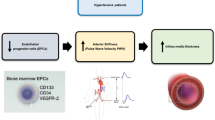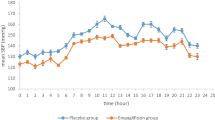Abstract
We investigated the effects of long-term benidipine treatment on levels of monocyte and endothelial cell activation markers in hypertensive patients with (n=28) and without (n=10) type 2 diabetes mellitus. Benidipine, 4 mg/day, was administered for 6 months; there were no other changes in any of the patients pharmacologic regimens during benidipine treatment. Clinical and biochemical data obtained before and after benidipine administration were compared; all markers were measured by ELISA. The levels of platelet activation markers (CD62P, CD63, and PAC-1), microparticles (monocyte-derived microparticles: MDMPs, and endothelial cell-derived microparticles: EDMPs), chemokines (monocyte chemotactic peptide 1: MCP-1, regulated on activation normally T-cell expressed and secreted: RANTES) and soluble adhesion markers (soluble E-selectin and soluble ICAM-1) differed in the control and hypertension groups. In addition, levels of platelet, monocyte, and endothelial cell activation markers, microparticles, chemokines, and soluble adhesion molecules were higher in hypertensive patients than in those without type 2 diabetes. Furthermore, benidipine administration decreased the concentrations of all these markers. The effect of this drug was significant in diabetes patients with high levels of antioxidized low-density lipoprotein (LDL) antibody. These results suggest that benidipine is effective for the treatment of oxLDL-dependent vascular disorders in hypertensive patients with type 2 diabetes.
This is a preview of subscription content, access via your institution
Access options
Subscribe to this journal
Receive 12 digital issues and online access to articles
$119.00 per year
only $9.92 per issue
Buy this article
- Purchase on Springer Link
- Instant access to full article PDF
Prices may be subject to local taxes which are calculated during checkout

Similar content being viewed by others
References
Morrish NJ et al. Risk factors for macrovascular disease in diabetes mellitus: The London follow-up to the WHO multinational study of vascular disease in diabetes. Diabetologia 1991; 34: 590–594.
Donahue RP, Orchard TJ . Diabetes mellitus and macrovascular complications: an epidemiological perspective. Diabet Care 1992; 15: 1141–1155.
Davis TM, Cull CA, Holman RR . Relationship between ethnicity and glycemic control, lipid profiles, and blood pressure during the first 9 years of type 2 diabetes: UK Prospective Diabet Study (UKPDS 55). Diabet Care 2001; 24: 1167–1174.
Lopes-Virella MF, Virella G . Immune mechanisms of atherosclerosis in diabetes mellitus. Diabetes 1992; 41 (Suppl 2): 86–91.
Carmassi F et al. Coagulation and fibrinolytic system impairment in insulin dependent diabetes mellitus. Thromb Res 1992; 67: 643–654.
Steiner M et al. Increased levels of soluble adhesion molecules in type 2 (non-insulin dependent) diabetes mellitus are independent of glycaemic control. Thromb Haemost 1994; 72: 979–984.
Cominacini L et al. E-selectin plasma concentration is influenced by glycaemic control in NIDDM patients: possible role of oxidative stress. Diabetologia 1997; 40: 584–589.
Drake TA, Ruf W, Morrissey JH, Edgington TS . Functional tissue factor is entirely surface expressed on lipopolysaccharide stimulated human blood monocytes and a constitutively tissue factor producing neoplastic cell line. J Cell Biol 1989; 109: 389–394.
Wilcox JN, Smith KM, Schwartz SM, Gordon D . Localization of tissue factor in normal vessel wall and in the atherosclerotic plaque. Proc Natl Acad Sci USA 1989; 86: 2839–2843.
Osnes LTN, Westvik AB, Kieruf P . Procoagulant and profibrinolytic activities of cryopreserved human monocytes. Thromb Res 1994; 76: 373–383.
Satta N et al. Monocyte vesiculation is a possible mechanism for dissemination of membrane-associated procoagulant activities and adhesion molecules after stimulation by lipopolysaccharide. J Immunol 1994; 153: 3245–3255.
Omoto S et al. Detection of monocyte-derived microparticles in patients with type II diabetes mellitus. Diabetologia 2002; 45: 550–555.
Hamilton KK, Hattori R, Esmon CT, Sims PJ . Complement proteins C5b-9 induce vesiculation of the endothelial plasma membrane and expose catalytic surface for assembly of the prothrombinase enzyme complex. J Biol Chem 1990; 265: 3809–3814.
Combes V et al. In vitro generation of endothelial microparticles and possible prothrombotic activity in patients with lupus anticoagulant. J Clin Invest 1999; 104: 93–102.
Rollins BJ, Yoshimura T, Leonard EJ, Pober JS . Cytokine-activated human endothelial cells synthesize and secrete a mono-chemoattractant, MCP-1/JE. Am J Pathol 1990; 136: 1229–1233.
Colotta F et al. Expression of a monocyte chemotactic cytokine by human mononuclear phagocytes. J Immunol 1992; 148: 760–765.
Ihm CG et al. A high glucose concentration stimulates the expression of monocyte chemotactic peptide 1 in human mesangial cells. Nephron 1998; 79: 33–37.
Baggiolini M, Dewald B, Moster B . Interleukin-8 and related chemotactic cytokine — CXC and CC chemokine. Adv Immunol 1994; 55: 97–179.
Kameyoshi Y et al. Cytokine RANTES released by thrombin-stimulated platelets is a potent attractant for human eosinophils. J Exp Med 1992; 176: 587–592.
Nomura S et al. Significance of chemokines and activated platelets in patients with diabetes. Clin Exp Immunol 2000; 121: 437–443.
Tschope D et al. Large platelets circulate in an activated state in diabetes. Semin Thromb Haemost 1994; 72: 519–522.
Dohi Y, Kojima M, Sato K . Benidipine improves endothelial function in renal resistance arteries of hypertensive rats. Hypertension 1996; 28: 58–63.
Karasawa A, Rochester JA, Ma XL, Lefer AM . Protection of endothelial damage and systemic shock by benidipine, a calcium antagonist, in rats subjected to splanchnic ischemia and reperfusion. Circulatory Shock 1991; 33: 135–141.
Zhang X, Hintze TH . Amlodipine releases nitric oxide from canin coronary microvessels: an unexpected mechanism of action of a calcium channel-blocking agent. Circulation 1998; 97: 576–580.
Kitakaze M et al. A Ca channel blocker, benidipine, increases coronary blood flow and attenuates the severity of myocardial ischemia via NO-dependent mechanisms in dogs. J Am Coll Cardiol 1999; 33: 242–249.
The National High Blood Pressure Education Program Working Group. National High Blood Pressure Education Program Working Group Report on Hypertension in diabetes. Hypertension 1994; 23: 145–158.
The Expert Committee on the Diagnosis and Classification of Diabetes Mellitus. Report of the expert commitee on the diagnosis and classification of diabetes mellitus. Diabet Care 1997; 20: 1183–1197.
Murakami T et al. Flow cytometric analysis of platelet activation markers CD62P and CD63 in patients with coronary artery disease. Eur J Clin Invest 1996; 26: 996–1003.
Nomura S et al. Activated platelet and oxidized LDL induce endothelial membrane vesiculation: clinical significance of endothelial cell-derived microparticles in patients with type 2 diabetes. Clin Appl Thromb/Hemost 2004; 10: 205–215.
Pugh JA, Medina RA, Cornell JC, Basu S . NIDDM is the major cause of diabetic end-stage renal disease: more evidence for a tri-ethnic community. Diabetes 1995; 4: 1375–1380.
Mattock MB et al. Microalbuminuria and coronary hear disease in non-insulin-dependent diabetes: an incidence study. Diabetes 1998; 47: 1786–1792.
Zucchelli P et al. Long-term comparison between captopril and nifedipine in the progression of renal insufficiency. Kidney Int 1992; 42: 452–458.
Kawata T, Hashimoto S, Koike T . Diversity in the renal hemodynamic effects of dihydropyridine calcium blockers in spontaneously hypertensive rats. J Cardiovasc Pharmacol 1997; 30: 431–436.
Kobayashi N et al. Benidipine stimulates nitric oxide synthase and improves coronary circulation in hypertensive rats. Am J Hypertens 1999; 12: 483–491.
Yamashita T et al. A calcium channel blocker, benidipine, inhibits intimal thickening in the carotid artery of mice by increasing nitric oxide production. J Hypertens 2001; 19: 451–458.
Asanuma H et al. Benidipine, a long-acting Ca channel blocker, limits infarct size via bradykinin- and NO-dependent mechanisms in canine hearts. Cardiovasc Drugs Ther 2001; 15: 225–231.
Nomura S et al. Effect of cilostazol on soluble adhesion molecules and platelet-derived microparticles in patients with diabetes. Thromb Haemost 1998; 80: 388–392.
Hilgers KF et al. Monocyte chemoattractant protein-1 and macrophage infiltration in hypertensive kidney injury. Kidney Int 2000; 58: 2408–2419.
Parissis JT et al. Serum profiles of granulocyte-macrophage colony-stimulating factor and C–C chemokines in hypertensive patients with or without significant hyperlipidemia. Am J Cardiol 2000; 85: 777–779.
Parissis JT et al. Plasma profiles of peripheral monocyte-related inflammatory markers in patients with arterial hypertension. Correlations with plasma endothelin-1. Int J Cardiol 2002; 83: 13–21.
Ross R . Atherosclerosis: an inflammatory disease. N Engl J Med 1999; 340: 115–126.
Bevilacqua MP, Nelson RM, Mannori G, Cecconi O . Endothelial-leukocyte adhesion molecules in human disease. Annu Rev Med 1994; 45: 361–378.
Adams DH, Shaw S . Leucocyte–endothelial interactions and regulation of leucocyte migration. Lancet 1994; 343: 831–836.
Napoli C et al. 1,4-dihydropyridine calcium channel blockers inhibit plasma and LDL oxidation and formation of oxidation-specific epitopes in the arterial wall and prolong survival in stroke-prone spontaneously hypertensive rats. Stroke 1999; 30: 1907–1915.
Kritz H et al. A new calsium antagonist, is a very potent inhibitor of LDL-oxidation. Prostaglandins Leukot Essent Fatty Acid 1999; 61: 183–188.
Cominacini L et al. Antioxidant activity of different dihydropyridines. Biochem Biophys Res Commun 2003; 302: 679–684.
Dale J, Landmark KH, Myhre E . The effects of nifedipine, calcium antagonist, on platelet function. Am Heart J 1983; 105: 103–105.
Sinzinger H et al. Isradipine improves platelet function in hypertensives. Eur J Clin Pharmacol 1992; 42: 43–46.
Tomoda F et al. Effects of a novel calcium antagonist, benidipine hydrochloride, on platelet responsiveness to mental stress in patients with essential hypertension. J Cardiovasc Pharmacol 1999; 34: 248–253.
Acknowledgements
This study was partly supported by a grant from the Japan Foundation of Neuropsychiatry and Hematology Research, a Research Grant for Advanced Medical Care from the Ministry of Health and Welfare, Japan, and a Grant (13670760 to SN) from the Ministry of Education, Science and Culture, Japan.
Author information
Authors and Affiliations
Corresponding author
Rights and permissions
About this article
Cite this article
Nomura, S., Shouzu, A., Omoto, S. et al. Benidipine improves oxidized LDL-dependent monocyte and endothelial dysfunction in hypertensive patients with type 2 diabetes mellitus. J Hum Hypertens 19, 551–557 (2005). https://doi.org/10.1038/sj.jhh.1001863
Received:
Revised:
Accepted:
Published:
Issue Date:
DOI: https://doi.org/10.1038/sj.jhh.1001863
Keywords
This article is cited by
-
Extracellular vesicles in coronary artery disease
Nature Reviews Cardiology (2017)
-
Innovative biomarkers for predicting type 2 diabetes mellitus: relevance to dietary management of frailty in older adults
Biogerontology (2016)
-
Microvesicles and diabetic complications — novel mediators, potential biomarkers and therapeutic targets
Acta Pharmacologica Sinica (2014)
-
Effect of nifedipine on adiponectin in hypertensive patients with type 2 diabetes mellitus
Journal of Human Hypertension (2007)
-
Endothelial progenitor cells in the vascular pathophysiology of hypertension: arterial stiffness, ageing and more
Journal of Human Hypertension (2006)



